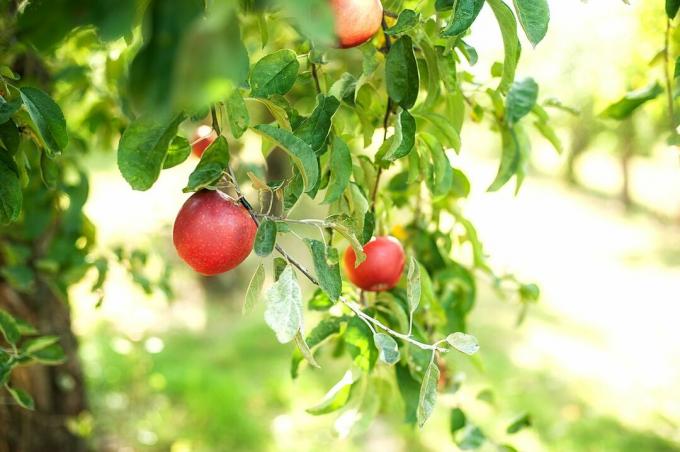The special apple variety 'Rubinette' from Switzerland is under plant variety protection. Here you can find out what else you need to know about properties, taste, harvest time and use.

A apple tree (Malus domestica) can probably be found in almost every larger garden. Among the numerous apple varietiesthat exist in the world, the 'Rubinette' is probably one of the most popular. No wonder, after all, the delicious apple captivates with a particularly intense aroma and exceptionally juicy fruit. In this article we will tell you what other characteristics have made the 'Rubinette' an insider tip among enthusiasts.
contents
- Rubinette: profile
- origin and history
- Properties and taste of ‘Rubinette’
- Peculiarities during cultivation
- Harvest time and use of the ‘Rubinette’ variety
Rubinette: profile
| synonyms | 'Rafzubin' |
| fruit | small to medium sized; green-yellow, striped orange-red on the sunny side |
| the taste | intense, sweet and sour, juicy |
| yield | tends to alternate |
| harvest time | October to December |
| maturity | October to December |
| shelf life | until January/February; prone to bearing rot |
| growth | weak to medium strong; sparse |
| climate | sheltered from the wind; Can be grown up to medium altitudes |
| diseases and pests | susceptible to scab, fruit tree canker and monilia |
origin and history
We owe the existence of the apple variety 'Rubinette' to a coincidence: it actually came into being today's popular variety from a chance seedling grown at the Hauenstein Nursery in Switzerland is. The parent strains of the newly emerged strain are ‘Golden Delicious' and 'Cox Orange', two equally well-known dessert apples. The 'Rubinette' has been under plant variety protection since 1985 and is now cultivated both conventionally and by hobby gardeners.
Properties and taste of ‘Rubinette’
The 'Rubinette' apple often looks a bit inconspicuous at first glance: With its small to medium-sized fruits and its green-yellow color, the 'Rubinette' often hardly stands out from others apple varieties. On the sunny side, the apples often show an orange-red, striped color. If you prefer a slightly more intensely colored version of the Rubinette apple, you can also go to the variety 'Rubinette Rosso' - the mutant of the well-known apple variety convinces with a particularly strong red color coloring.
In terms of taste, the 'Rubinette' convinces above all with its intense aroma and pleasant taste. The sweet-sour note and the high sugar content in particular make the apple extraordinarily delicious. The pleasure is rounded off by the firm flesh, which is both crisp and juicy.
Peculiarities during cultivation
Although its apples score with a superior taste, the 'Rubinette' apple tree has none unusual demands on its environment: a nutrient-rich soil and a sunny location are enough tree already out. However, the soil around the Rubinette tree should be kept constantly moist until it grows, but later it usually only needs to be watered in particularly dry times.
In theory, the variety is suitable for any form of cultivation due to its rather low requirements, even in the bucket as a columnar apple tree, the 'Rubinette' is well suited. However, the tree tends to have a sparse, unbranched growth and alternation, which is why one on regular trimmings shouldn't give up.

However, one of the main problems encountered when growing 'Rubinette' is its high susceptibility to Apple Tree Diseases. As a descendant of two high-performance varieties, 'Rubinette' is particularly susceptible to scab (Venturia inaequalis), a fungal disease that spreads well, especially in wet and warm conditions, which is why regular care (including pruning) should not be neglected. But also fruit tree cancer (Neonectria galligena) and Monilia (Monilinia) are more common in trees of this variety. In order for the Rubinette apple tree to remain healthy in the long term, it should therefore be checked regularly for signs of disease. In addition, they should be treated as soon as possible. In addition, it is advisable to only visit a specialist shop to buy a 'Rubinette' - here the young trees are checked for signs of possible disease before they are sold.
Harvest time and use of the ‘Rubinette’ variety
The Rubinette apple harvest season begins in early October and can last into December. Since the variety is one of the real table apples, it is ready to eat from this moment on and can be eaten without after-ripening. Due to its excellent taste, the 'Rubinette' is used as a dessert apple, i.e. it is mainly eaten raw. However, the fruits are also wonderful for cakes or pastries. In addition, the Rubinette apple is considered to be very allergy-friendly, even if intolerance to apples often varies from person to person. Apples, on the other hand, are not suitable for diabetics – they have too high a sugar content.
At the 'Joseph Mush' It is also a dessert apple, which is also very suitable for cider. In addition, the 'Josef Musch' is a somewhat easy-care and not so susceptible apple tree representative.



